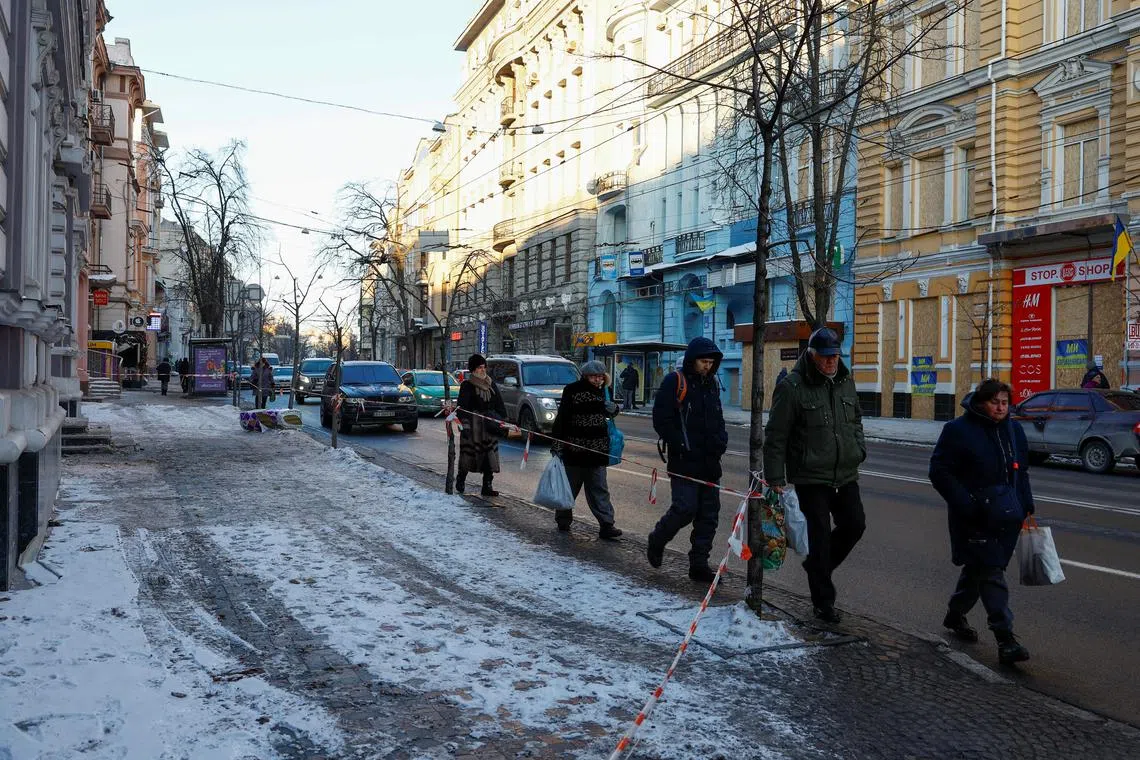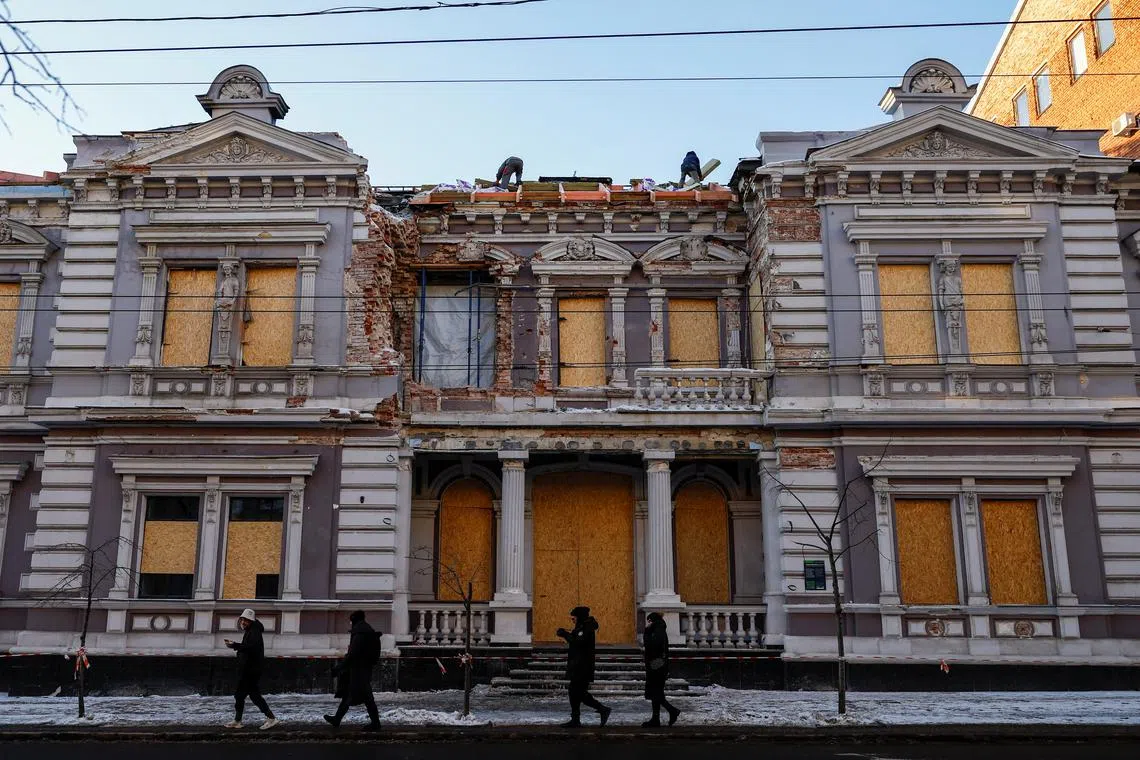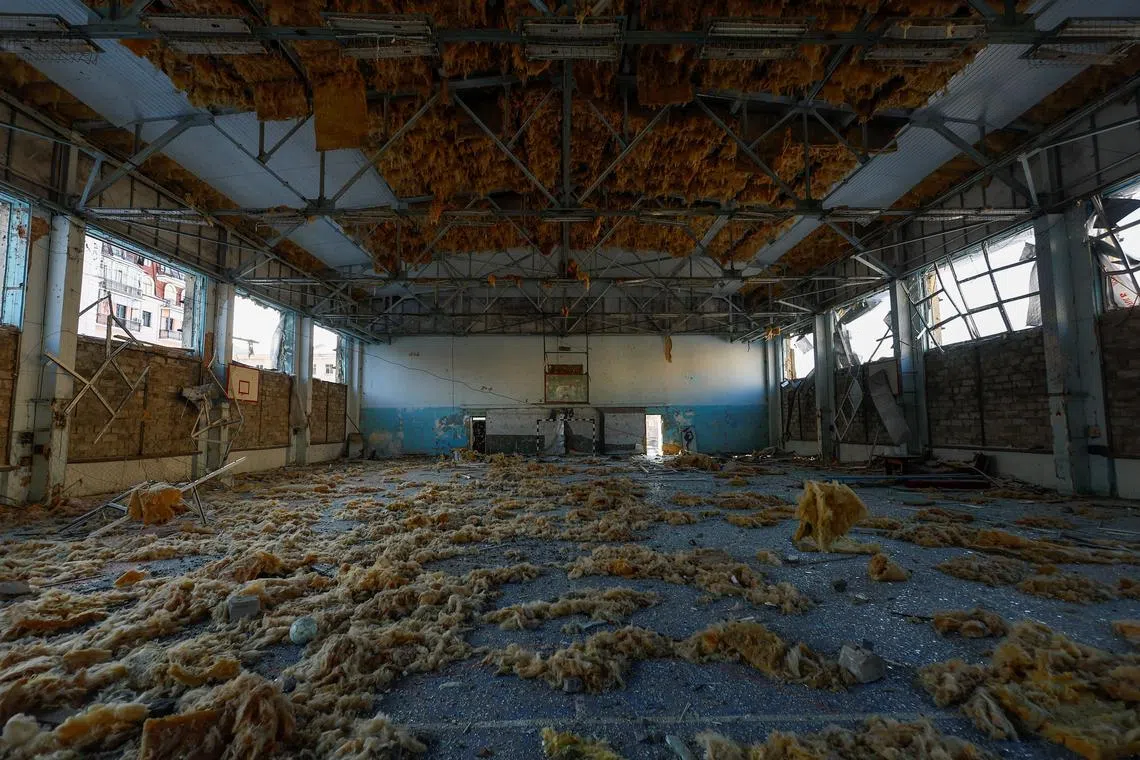Ukraine’s second city Kharkiv keeps going despite Russian attacks
Sign up now: Get ST's newsletters delivered to your inbox

People walking along a street next to historical buildings in Kharkiv, Ukraine, which were damaged during a Russian drone strike.
PHOTO: REUTERS
Follow topic:
KHARKIV, Ukraine - For a city under frequent attack by Russia, Kharkiv in north-eastern Ukraine is functioning surprisingly well: the streets hum with activity during the day, cafes are busy, and there is even some night life.
Officials say around 1.2 million people remain in the country's second city - compared to nearly 2 million before Moscow's Feb 24, 2022 invasion
Among them are some who returned to this cultural and scientific hub after seeking the relative safety of western Ukraine early in the war, when Russian troops reached the outskirts of the city.
They have done so despite the risk of living in a city that is close to the front line and only 42km from the border with Russia.
"I felt more life here in one day than three months out there," said Ms Kateryna Pereverzeva, a 29-year-old magazine editor who came back after three months.
Sitting in a cosy downtown cafe, she told Reuters she had no intention of leaving again despite Russian attacks intensifying.
The latest wave began on Dec 29, 2023
Since then, 17 people have been killed and 168 wounded in the city alone, according to the United Nations.
On the deadliest day since attacks intensified, 10 people were killed and dozens wounded in multiple strikes on Jan 23.
A family of five and an elderly couple were killed in a drone attack on an oil depot on Feb 9.
Hotels, historic buildings and apartment blocks have also been battered and among the weapons launched at Kharkiv in recent weeks were missiles from North Korea, according to Ukrainian authorities.
Kharkiv is less well protected by air defences than the capital Kyiv, and is more vulnerable to missiles fired from nearby.
Their elusive trajectory and short time in the air mean they are difficult to shoot down, and sometimes land before air-raid warnings go off.

Young people dancing at the compound of the new art and performance centre in Kharkiv, Ukraine.
PHOTO: REUTERS
‘Illusion of peace’
Despite the frequent danger, there is a daytime bustle in Kharkiv, and many businesses affected by strikes bounce back quickly, said Ms Nataliia Popova, an adviser to the regional council.
But the city feels under siege, and boarded-up shop-fronts serve up a constant reminder of the war. The city's historic architecture, an impressive mixture of Tsarist and Soviet-era structures, is also pockmarked by artillery fires.
At night, an eerie silence grips the city when its broad avenues go dark even before the 11pm curfew.
"You feel this illusion of peaceful life," said Ms Mykola Demydenko, 26, who opened a barber shop downtown last summer.
In late December 2023, a Russian drone smashed into a building near Ms Demydenko's home and studio, blowing out the studio's windows.
Some residents believe Kharkiv's precarious situation has helped galvanise them and bolster their appreciation of the city's heritage.

People walk past as workers repair the roof of a historical building that was damaged during one of Russia’s drone strikes.
PHOTO: REUTERS
By the time Ukraine gained independence in 1991, the city was heavily Russified and a bastion of pro-Moscow politics.
But the war has put that dynamic into reverse, said Mr Anton Nazarko, co-founder of a new art and performance centre who says Kharkiv now has an "historic opportunity" to carve out an identity free of Russian influence.
On a recent cold evening, revellers filed through tight security and packed into an industrial space that is called the Centre for New Culture, and was once a Soviet-era refrigeration equipment factory, for an electronic music concert.
"If we don't want the city to lose this creative spark, we need to do things right now, to start building right now," Mr Nazarko, 37, said as heavy bass boomed in the background.
Local officials have signalled a similar interest in forging a new identity, part of a nationwide drive to sever cultural and historical ties to Moscow.
In November 2023, the Kharkiv national opera and ballet theatre commissioned a city anthem, and Mayor Ihor Terekhov has proposed renaming a central street after Ukrainian philosopher Hryhoryi Skovoroda instead of Russian poet Alexander Pushkin.

A sports complex facility in Kharkiv which was heavily damaged by a missile strike at the beginning of Russia’s full-scale invasion.
PHOTO: REUTERS
Ballistics expertise
As in other cities bombarded by Russia, people in Kharkiv have learned to adapt.
Standing near her own badly damaged apartment building, Ms Popova, who advises regional officials on humanitarian affairs, explained why hallways and bathrooms offer the best protection locals can hope for when hiding from air strikes.
Bomb shelters are of little use when ballistic missiles hit with little warning.
"Because let's be honest: to head to some basement in 40 seconds, or to run to the metro, is unrealistic," Ms Popova said.
She survived a Jan 2 strike on her courtyard by dashing into the bathroom with her young son.
Because of the almost instant threat, she said, many locals rely on Telegram channels whose Ukrainian administrators spot the launches themselves, saving vital seconds.
The UN has said that at least 79 missiles and drones have hit residential areas of Kharkiv since Dec 29.
Inside Ms Popova's courtyard, a veteran recovering from an injury led his son through the ravaged shell of a former gym.
So familiar have residents become with the different incoming ordnance, said Ms Pereverzeva, the magazine editor, that they are often able to differentiate one from another.
"An S-300 (long-range missile) hitting somewhere near you is still not as loud as an Iskander (short-range missile) landing far away," she said. REUTERS

